Rapid Earthquake Damage Assessment and Education to Improve Earthquake Response Efficiency and Community Resilience
Abstract
:1. Introduction
2. The REDACt Project Methodology
2.1. Project Objectives, Targets, Expected Results
- The first one is to develop, as a Decision Supporting System, a Rapid Earthquake Damage Assessment platform (REDA.p) which can support authorities to make informed decisions during the Prevention and Preparedness phases, and to provide situational awareness during emergencies regarding the spatial distribution of the expected level of damage. REDA.p produces outputs with improved accuracy and reliability in urban areas by receiving readings from a dense monitoring network of low-cost accelerometers, installed in selected school buildings.
- The second part of the action aims at improving Public Response always in line with State Emergency plans by:
- Developing a smartphone app to provide guidance, best practices and the ability to provide feedback and felt reports during an emergency.
- Developing an Educational Hub which answers problems related to public response, as identified by Competent Authorities at a National level.
- Both scenario-based and near Real-Time (Rapid) Earthquake Damage Assessment. The REDA.p integrates real-time seismic data from various monitoring stations from various providers including ITSAK/EPPO (Greece), NIEP (Romania) and AFAD (Türkiye) to detect earthquakes promptly. Utilizing geological, engineering geological/geotechnical and structural data, the system employs predictive models to estimate ground motion parameters and potential earthquake damage based on user defined scenarios. When triggered by any of the earthquake monitoring networks, the platform calculates ground motion parameters, produces the respective shakemaps, and, based on the available for the area vulnerability and/or geotechnical data, produces the respective earthquake damage distribution maps (Figure 1).
- Smartphone app. It provides (i) education and training to users; (ii) information regarding the event; (iii) a map of safe locations in the area; (iv) the capability of sending an “I am safe” message to selected contacts; (v) the capability of sending feedback as “felt-reports”; and (vi) access to the project website where they can find more information, guidelines and tools to implement their own emergency plans.
- Educational Hub (Edu.Hub). The scope of the educational hub is to investigate the reasons influencing public behavior during earthquake emergencies and to offer solutions for improvement. It capitalizes on educational material published by competent Authorities at National and Regional Levels and based on internationally recognized and widely acceptable principles, it attempts to constructively contribute towards improving public prevention, preparedness and response capacities against earthquake-related risks.
2.2. Project Design and Structure
2.3. Research Subjects
2.3.1. Ground Motion Prediction Equations and Selection of Seismic Sources
2.3.2. Earthquake Damage Assessment of Buildings and Gas Pipelines
- seismic intensity values and direct correlations with potential of casualties and economic losses;
- seismic intensity values and vulnerability functions for buildings with casualty models;
- seismic PGA, PGV and Sa values, capacity and fragility functions or directly vulnerability functions for structures;
- more empirical approaches (but generally less used), relying on GIS multi-criteria decision analysis.
2.3.3. Earthquake Triggered Landslides and Liquefactions
2.3.4. The Smartphone App
2.3.5. The Educational Hub
3. Main Research Outputs, Evaluation and Results
3.1. The REDA.p and the Harmonization Framework
3.2. The Edu.Hub and the Smartphone App
- Education to help raise public awareness;
- Tutorials to help people develop their own emergency plans and respond more efficiently by also acquiring situational awareness regarding their own interests and concerns;
- Supports the public by providing maps of safe locations where they can navigate directly from the Edu.Hub with two clicks;
- An evaluation of the coverage of safe locations provided to urban areas given a maximum walking time of five minutes.
4. Discussion
5. Conclusions
- A REDA platform which can provide both scenario-based and near Real-Time damage assessment including buildings, gas pipelines and geotechnical failures such as landslides and liquefaction.
- A smartphone app, which provides the public with event related data and offers communication capabilities such as sending a reassuring message, submitting a felt report and having access to a map of safe areas.
- An Educational Hub, which attempts to raise public awareness, promote volunteering at a neighborhood level and offers solutions to help the public acquire the situational awareness it needs during emergencies. It also provides a navigation-able sample map of safe locations to demonstrate its potential use by competent authorities at various levels of administration.
Author Contributions
Funding
Institutional Review Board Statement
Informed Consent Statement
Data Availability Statement
Acknowledgments
Conflicts of Interest
References
- Galanopoulos, A.G. On Mapping of Seismic Activity in Greece. Annali Geof. 1963, 16, 37–100. [Google Scholar] [CrossRef]
- Comninakis, P.E.; Papazachos, B.C. A Catalogue of Earthquakes in Greece and Surrounding Area for Period 1901–1985. Publ. Geophys. Lab. Univ. Thessalon. 1986, 1, 1–167. [Google Scholar]
- Ambraseys, N.N.; Finkel, C.F. Seismicity of Turkey and Adjacent Areas, A Historical Review, 1500–1800; ErenYayincilik ve Kitapcilik Ltd.: Istanbul, Turkey, 1995; p. 240. [Google Scholar]
- Grünthal, G.; Wahlström, R.; Stromeyer, D. The SHARE European Earthquake Catalogue (SHEEC) for the Time Period 1900–2006 and its Comparison to EMEC. J. Seismol. 2013, 17, 1339–1344. [Google Scholar] [CrossRef]
- Sesetyan, K.; Demircioglu, M.B.; Rovida, A.; Albini, P.; Stucchi, M. SHARE-CET, the SHARE Earthquake Catalogue for Central and Eastern Turkey Complementing the SHARE European Earthquake Catalogue (SHEEC). 2013. Available online: https://emidius.eu/SHEEC/docs/SHARE_CET.pdf (accessed on 16 October 2023).
- Giardini, D.; Woessner, J.; Danciu, L.; Crowley, H.; Cotton, F.; Grünthal, G.; Pinho, R.; Valensise, G.; Akkar, S.; Arvidsson, R.; et al. Seismic Hazard Harmonization in Europe (SHARE). Online Data Resour. 2013. [Google Scholar] [CrossRef]
- Ambraseys, N.N.; Finkel, C.F. Long-Term Seismicity of Istanbul and of the Marmara Sea Region. Terra Nova 1991, 3, 527–539. [Google Scholar] [CrossRef]
- INFP. Romplus Romanian Earthquake Catalogue. 2020. Available online: https://data.mendeley.com/datasets/tdfb4fgghy/2 (accessed on 10 December 2020).
- Oncescu, M.C.; Marza, V.I.; Rizescu, M.; Popa, M. The Romanian Earthquake Catalogue between 984–1997. In Vrancea Earthquakes: Tectonics, Hazard and Risk Mitigation; Springer: Dordrecht, The Netherlands, 1999; pp. 43–47. [Google Scholar]
- Platon, V.; Constantinescu, A. Evolution of Urban Structures in Romania and Some EU Countries. Procedia Econ. Financ. 2015, 32, 139–145. [Google Scholar] [CrossRef]
- Theodora, G.; Loukakis, P. Trends of Evolution in the Residential Network of Greek Urban Centers. In Urban and Spatial Planning Developments. Greece 1952–2012: Action Experiences; University of Thessaly Editions: Volos, Greece, 2011; pp. 177–192. [Google Scholar]
- Papathanassiou, G.; Valkaniotis, S.; Chaztipetros, A.; Pavlides, S. Liquefaction susceptibility map of Greece. Bull. Geol. Soc. Greece 2010, 43, 1383–1392. [Google Scholar] [CrossRef]
- Ambraseys, N.N.; Finkel, C.F. The Saros-Marmara Earthquake of 9 August 1912. Earthq. Eng. Struct. Dyn. 1987, 15, 189–211. [Google Scholar] [CrossRef]
- Papathanassiou, G.; Pavlides, S.; Christaras, B.; Pitilakis, K. Liquefaction Case Histories and Empirical Relations of Earthquake Magnitude Versus Distance from the Broader Aegean Region. J. Geodyn. 2005, 40, 257–278. [Google Scholar] [CrossRef]
- Crowley, H.; Despotaki, V.; Rodrigues, D.; Silva, V.; Toma-Danila, D.; Riga, E.; Karatzetsou, A.; Sousa, L.; Ozcebe, S.; Zugic, Z.; et al. Exposure Model for European Seismic Risk Assessment. Earthq. Spectra 2020, 36, 252–273. [Google Scholar] [CrossRef]
- Hellenic Statistical Authority (ELSTAT). 2011 Buildings Census; Hellenic Statistical Authority (ELSTAT): Piraeus, Greece, 2015. [Google Scholar]
- Alcaz, V.; Troian, S. Rețeaua de Clădiri Reprezentative-Element Indispensabil în Monitorizarea Riscului Seismic în Republica Moldova. Bul. Inst. Geol. Seismol. AŞM 2016, 2, 113–120. [Google Scholar]
- Armaş, I.; Toma-Danila, D.; Ionescu, R.; Gavriş, A. Vulnerability to Earthquake Hazard: Bucharest Case Study, Romania. Int. J. Disaster Risk Sci. 2017, 82, 182–195. [Google Scholar] [CrossRef]
- D’Ayala, D.; Kappos, A.; Crowley, H.; Antoniadis, P.; Colombi, M.; Kishali, E.; Panagopoulos, G.; Silva, V. Providing Building Vulnerability Data and Analytical Fragility Functions for PAGER; Earthquake Engineering Research Institute: Oakland, CA, USA, 2012. [Google Scholar]
- Fotopoulou, S.; Karapetrou, S.; Pitilakis, K. Seismic Vulnerability of RC Buildings Considering SSI and Aging Effects. In Proceedings of the 15WCEE International Conference, Lisboa, Portugal, 24–28 September 2012. [Google Scholar]
- Kappos, A.J. An Overview of the Development of the Hybrid Method for Seismic Vulnerability Assessment of Buildings. Struct. Infrastruct. Eng. 2016, 12, 1573–1584. [Google Scholar] [CrossRef]
- Karakostas, C.; Lekidis, V.; Kappos, A.J.; Panagopoulos, G.K.; Keramitsoglou, I.; Kontoes, C. Evaluation of Seismic Vulnerability of Buildings in Athens and L’Aquila in the Framework of the MASSIVE Seismic Mitigation System. In Proceedings of the 15th World Conference on Earthquake Engineering (15 WCEE), Lisbon, Portugal, 24–28 September 2012. [Google Scholar]
- Kassem, M.M.; Mohamed Nazri, F.; Noroozinejad Farsangi, E. The seismic vulnerability assessment methodologies: A state-of-the-art review. Ain Shams Eng. J. 2020, 11, 849–864. [Google Scholar] [CrossRef]
- Maio, R.; Tsionis, G. Seismic Fragility Curves for the European Building Stock: Review and Evaluation of Existing Fragility Curves; JRC99561; Publications Office of the European Union: Luxembourg, 2015. [Google Scholar]
- Rossetto, T.; Ioannou, I.; Grant, D.N. Existing Empirical Fragility and Vulnerability Functions: Compendium and Guide for Selection; (GEM Technical Report 2015-1); University College London: London, UK, 2015. [Google Scholar]
- Shabani, A.; Kioumarsi, M.; Zucconi, M. State of the art of simplified analytical methods for seismic vulnerability assessment of unreinforced masonry buildings. Eng. Struct. 2021, 239, 112280. [Google Scholar] [CrossRef]
- Seismology and Earthquake Engineering Research Infrastructure Alliance for Europe-SERA Project. 2020. Funded under the “EXCELLENT SCIENCE-Research Infrastructures”; Publications Office of the European Union: Luxembourg, 2020.
- Mouroux, P.; Brun, B.L. Presentation of RISK-UE Project. Bull. Earthq. Eng. 2006, 4, 323–339. [Google Scholar] [CrossRef]
- Pitilakis, K.; Franchin, P.; Khazai, B.; Wenzel, H. SYNER-G: Systemic Seismic Vulnerability and Risk Assessment of Complex Urban, Utility, Lifeline Systems and Critical Facilities—Methodology and Applications; Springer: Dordrecht, The Netherlands, 2014. [Google Scholar]
- Akkar, S.; Bossu, R.; Cauzzi, C.; Clinton, J.; D’Amico, M.; Eck, T.; Frobert, L.; Godey, S.; Gueguen, P.; Kästli, P.; et al. Network of european research infrastructures for earthquake risk assessment and mitigation (NERA)—Networking accelerometric networks and SM data users (NA3). In Proceedings of the 2ECEES, Instabul, Turkey, 24–29 August 2014. [Google Scholar]
- Lagomarsino, S.; Cattari, S.; Calderini, C.; D’Ayala, D.; Modaressi, H.; Pitilakis, K.; Bosiljkov, V.; Benouar, D. PERPETUATE Project: The Proposal of a Performance-Based Approach to Earthquake Protection of Cultural Heritage. Adv. Mater. Res. 2010, 133, 1119–1124. [Google Scholar] [CrossRef]
- Silva, V.; Amo-Oduro, D.; Calderon, A.; Costa, C.; Dabbeek, J.; Despotaki, V.; Martins, L.; Pagani, M.; Rao, A.; Simionato, M.; et al. Development of a global seismic risk model. Earthq. Spectra 2020, 36, 372–394. [Google Scholar] [CrossRef]
- Iturburu, L.; Kwannandar, J.; Dyke, S.J.; Liu, X.; Zhang, X.; Ramirez, J. Towards rapid and automated vulnerability classification of concrete buildings. Earthq. Eng. Eng. Vib. 2023, 22, 309–332. [Google Scholar] [CrossRef]
- Kazemi, F.; Asgarkhani, N.; Jankowski, R. Machine learning-based seismic fragility and seismic vulnerability assessment of reinforced concrete structures. Soil Dyn. Earthq. Eng. 2023, 166, 107761. [Google Scholar] [CrossRef]
- Mitropoulou, C.C.; Papadrakakis, M. Developing fragility curves based on neural network IDA predictions. Eng. Struct. 2011, 33, 3409–3421. [Google Scholar] [CrossRef]
- Morfidis, K.; Kostinakis, K. Comparative evaluation of MFP and RBF neural networks’ ability for instant estimation of r/c buildings’ seismic damage level. Eng. Struct. 2019, 197, 109436. [Google Scholar] [CrossRef]
- Ruggieri, S.; Cardellicchio, A.; Leggieri, V.; Uva, G. Machine-learning based vulnerability analysis of existing buildings. Autom. Constr. 2021, 132, 103936. [Google Scholar] [CrossRef]
- Ruggieri, S.; Liguori, F.S.; Leggieri, V.; Bilotta, A.; Madeo, A.; Casolo, S.; Uva, G. An archetype-based automated procedure to derive global-local seismic fragility of masonry building aggregates: META-FORMA-XL. Int. J. Disaster Risk Reduct. 2023, 95, 103903. [Google Scholar] [CrossRef]
- Sainct, R.; Feau, C.; Martinez, J.-M.; Garnier, J. Efficient methodology for seismic fragility curves estimation by active learning on Support Vector Machines. Struct. Saf. 2020, 86, 101972. [Google Scholar] [CrossRef]
- Tang, Q.; Dang, J.; Cui, Y.; Wang, X.; Jia, J. Machine Learning-Based Fast Seismic Risk Assessment of Building Structures. J. Earthq. Eng. 2022, 26, 8041–8062. [Google Scholar] [CrossRef]
- Zucconi, M.; Romano, F.; Ferracuti, B. Typological fragility curves for RC buildings: Influence of damage index and building sample selection. Eng. Struct. 2022, 266, 114627. [Google Scholar] [CrossRef]
- FEMA. Hazus Earthquake Model User Guidance, V.5.1.; FEMA: Washington, DC, USA, 2022. [Google Scholar]
- Erdik, M.; Sesetyan, K.; Demircioglu, M.; Hancilar, U.; Zulfikar, C.; Cakti, E.; Kamer, Y.; Yenidogan, C.; Tuzun, C.; Cagnan, Z.; et al. Rapid Earthquake Hazard and Loss Assessment for Euro-Mediterranean Region. Acta Geophys. 2010, 58, 855–892. [Google Scholar] [CrossRef]
- U.S. Geological Survey. PAGER—Prompt Assessment of Global Earthquakes for Response; U.S. Geological Survey: Reston, VA, USA, 2017. [Google Scholar]
- Molina, D.H.; Lang, C.D.; Lindholm, C. SELENA—An Open-Source Tool for Seismic Risk and Loss Assessment Using a Logic Tree Computation Procedure. Comput. Geosci. 2010, 36, 257–269. [Google Scholar] [CrossRef]
- Pagani, M.; Monelli, D.; Weatherill, G.; Danciu, L.; Crowley, H.; Silva, V.; Henshaw, P.; Butler, L.; Nastasi, M.; Panzeri, L.; et al. OpenQuake Engine: An Open Hazard (and Risk) Software for the Global Earthquake Model. Seismol. Res. Lett. 2014, 85, 692–702. [Google Scholar] [CrossRef]
- Yalçın, D.; Eravcı, Y.; Yanik, K.; Baykal, M.; Yenilmez, G.; Çetin, C. Afad-Red Rapid Earthquake Damage and Loss Estimation Software: Example of Adıyaman Samsat Earthquake. In Proceedings of the 9th Congress of the Balkan Geophysical Society, Antalya, Turkey, 5–9 November 2017. [Google Scholar]
- Moldovan, I.A.; Diaconescu, M.; Popescu, E.; Radulian, M.; Toma-Danila, D.; Constantin, A.P.; Placinta, A.O. Input Parameters for the Probabilistic Seismic Hazard Assessment in the Eastern Part of Romania and Black Sea Area. Rom. J. Phys. 2016, 61, 1412–1425. [Google Scholar]
- Munteanu, I.; Matenco, L.; Dinu, C.; Cloetingh, S. Kinematics of Back-Arc Inversion of the Western Black Sea Basin. Tectonics 2011, 30, TC5004. [Google Scholar] [CrossRef]
- Cotton, F.; Scherbaum, F.; Bommer, J.J.; Bungum, H. Criteria for Selecting and Adjusting Ground Motion Models for Specific Target Regions: Application to Central Europe and Rock Sites. J. Seismol. 2006, 10, 137–156. [Google Scholar] [CrossRef]
- Bommer, J.J.; Douglas, J.; Scherbaum, F.; Cotton, F.; Bungum, H.; Fah, D. On the Selection of Ground Motion Prediction Equations for Seismic Hazard Analysis. Seismol. Res. Lett. 2010, 81, 783–793. [Google Scholar] [CrossRef]
- Scherbaum, F.; Cotton, F.; Smit, P. On the Use of Response Spectral-Reference Data for the Selection and Ranking of Ground-Motion Models for Seismic-Hazard Analysis in Regions of Moderate Seismicity: The Case of Rock Motion. Bull. Seismol. Soc. Am. 2004, 94, 2164–2185. [Google Scholar] [CrossRef]
- Sotiriadis, D.; Margaris, B. Evaluation of the predictive performance of regional and global ground motion predictive equations against Greek strong motion data. Soil Dyn. Earthq. Eng. 2023, 165, 107656. [Google Scholar] [CrossRef]
- Boore, D.; Stewart, J.P.; Skarlatoudis, A.; Seyhan, E.; Margaris, B.; Theodoulidis, N.; Scordilis, E.; Kalogeras, I.; Klimis, N.; Melis, N. A Ground-Motion Prediction Model for Shallow Crustal Earthquakes in Greece. Bull. Seismol. Soc. Am. 2021, 111, 857–874. [Google Scholar] [CrossRef]
- Chiou, B.S.J.; Youngs, R.R. Update of the Chiou and Youngs NGA model for the average horizontal component of peak ground motion and response spectra. Earthq. Spectra 2014, 30, 1117–1153. [Google Scholar] [CrossRef]
- Cioflan, C.O.; Manea, E.F.; Danciu, L.; Coman, A.; Mărmureanu, A. Evaluation of up-to-date ground motion models for inslab earthquakes in Romania. In Proceedings of the Geoscience International Symposium, Bucharest, Romania, 20–21 November 2020. [Google Scholar]
- Douglas, J. Ground Motion Prediction Equations 1964–2020. 2020. Available online: http://www.gmpe.org.uk/ (accessed on 10 October 2023).
- Sokolov, V.; Bonjer, K.P.; Wenzel, F.; Grecu, B.; Radulian, M. Ground-motion prediction equations for the intermediate depth Vrancea (Romania) earthquakes. Bull. Earthq. Eng. 2008, 6, 367–388. [Google Scholar] [CrossRef]
- Atkinson, G.M.; Boore, D.M. Empirical ground-motion relations for subduction-zone earthquakes and their application to Cascadia and other regions. Bull. Seismol. Soc. Am. 2003, 93, 1703–1729. [Google Scholar] [CrossRef]
- Vacareanu, R.; Radulian, M.; Iancovici, M.; Pavel, F.; Neagu, C. Fore-arc and back-arc ground motion prediction model for Vrancea intermediate depth seismic source. J. Earthq. Eng. 2015, 19, 535–562. [Google Scholar] [CrossRef]
- García, D.; Singh, S.K.; Herráiz, M.; Ordaz, M.; Pacheco, J.F. Inslab earthquakes of central Mexico: Peak ground-motion parameters and response spectra. Bull. Seismol. Soc. Am. 2005, 95, 2272–2282. [Google Scholar] [CrossRef]
- Wald, D.; Allen, T. Topographic Slope as a Proxy for Seismic Site Conditions and Amplification. Bull. Seismol. Soc. Am. 2007, 97, 1379–1395. [Google Scholar] [CrossRef]
- Allen, T.; Wald, D. On the Use of High-Resolution Topographic Data as a Proxy for Seismic Site Conditions (VS30). Bull. Seismol. Soc. Am. 2009, 99, 935–943. [Google Scholar] [CrossRef]
- Crowley, H.; Pinho, R.; Pagani, M.; Keller, N. Assessing global earthquake risks: The Global Earthquake Model (GEM) initiative. In Handbook of Seismic Risk Analysis and Management of Civil Infrastructure Systems; Woodhead Publishing: Cambridge, UK, 2013; pp. 815–838. [Google Scholar]
- Martins, L.; Silva, V. Development of a fragility and vulnerability model for global seismic risk analyses. Bull. Earthq. Eng. 2021, 19, 6719–6745. [Google Scholar] [CrossRef]
- Penelis, G.G.; Sarigiannis, D.; Stavrakakis, E.; Stylianidis, K.C. A statistical evaluation of damage to buildings in the Thessaloniki, Greece, earthquake of June, 20, 1978. In Proceedings of the 9th World Conference on Earthquake Engineering, Tokyo, Japan, 1988; Science Council of Japan: Tokyo, Japan, 1988; Volume VII, pp. 187–192. [Google Scholar]
- Leventakis, G.A. Microzonation Study of the City of Thessaloniki. Ph.D. Thesis, Aristotle University of Thessaloniki, Thessaloniki, Greece, 2003. (In Greek). [Google Scholar]
- Pitilakis, K.; Crowley, H.; Kaynia, A.M. SYNER-G: Typology Definition and Fragility Functions for Physical Elements at Seismic Risk. Geotech. Geol. Earthq. Eng. 2014, 27, 1–28. [Google Scholar]
- Chen, W.W.; Shih, B.J.; Chen, Y.C.; Hung, J.H.; Hwang, H.H. Seismic Response of Natural Gas and Water Pipelines in the Ji-Ji Earthquake. Soil Dyn. Earthq. Eng. 2002, 22, 1209–1214. [Google Scholar] [CrossRef]
- O’Rourke, M.; Filipov, E.; Uçkan, E. Towards Robust Fragility Relations for Buried Segmented Pipe in Ground Strain Areas. Earthq. Spectra 2015, 31, 1839–1858. [Google Scholar] [CrossRef]
- Zhu, J.; Baise, L.; Thompson, E. An Updated Geospatial Liquefaction Model for Global Application. Bull. Seismol. Soc. Am. 2017, 107, 1365–1385. [Google Scholar] [CrossRef]
- Iwasaki, T.; Tokida, K.; Tatsuoka, F.; Watanabe, S.; Yasuda, S.; Sato, H. Microzonation for soil liquefaction potential using simplified methods. In Proceedings of the 3rd International Conference on Microzonation, Seattle, WA, USA, 28 June–1 July 1982; Volume 3, pp. 1310–1330. [Google Scholar]
- Jessee, M.A.; Hamburger, M.W.; Allstadt, K.; Wald, D.J.; Robeson, S.M.; Tanyas, H.; Hearne, M.; Thompson, E. A global empirical model for near-real-time assessment of seismically induced landslides. J. Geophys. Res. Earth Surf. 2018, 123, 1835–1859. [Google Scholar] [CrossRef]
- SciNetNatHaz Project. Landslide Hazard Assessment-Pilot Implementations. Deliverable D03.01_Vol.2. 2015. Available online: http://scinetnathaz.net/wp-content/uploads/2016/11/D_03_01_Vol_2_landslides_HA.pdf (accessed on 16 October 2023).
- Sapountzaki, K. Evacuation of Buildings and Finding Refuge in Safe Areas for the Population. Manual No. 3; Earthquake Planning & Protection Organization of Greece (EPPO), Hellenic Ministry of the Environment, Spatial Planning and Public Works, European Centre for Earthquake Prevention and Forecasting: Athens, Greece, 2021. [Google Scholar]
- Carter, H.; Drury, J.; Amlot, R.; Rubin, G.J.; Williams, R. Perceived Responder Legitimacy and Group Identification Predict Cooperation and Compliance in a Mass Decontamination Field Exercise. Basic Appl. Soc. Psychol. 2013, 35, 575–585. [Google Scholar] [CrossRef]
- Carter, H.; Drury, J.; Rubin, G.J.; Williams, R.J.; Amlot, R. Effective Responder Communication Improves Efficiency and Psychological Outcomes in a Mass Decontamination Field Experiment: Implications for Public Behaviour in the Event of a Chemical Incident. PLoS ONE 2014, 9, e89846. [Google Scholar] [CrossRef] [PubMed]
- Stott, C.; Hutchison, P.; Drury, J. “Hooligans” Abroad? Inter-Group Dynamics, Social Identity and Participation in Collective “Disorder” at the 1998 World Cup Finals. Br. J. Soc. Psychol. 2001, 40, 359–384. [Google Scholar] [CrossRef] [PubMed]
- Feinberg, W.E.; Johnson, N.R. The Ties That Bind: A Macro-Level Approach to Panic. Int. J. Mass Emerg. Disasters 2001, 193, 269–295. [Google Scholar] [CrossRef]
- Drury, J.; Cocking, C.; Reicher, S. The Nature of Collective Resilience: Survivor Reactions to the 2005 London Bombings. Int. J. Mass Emerg. Disasters 2009, 27, 66–95. [Google Scholar] [CrossRef]
- Bendersky, J. ‘Panic’: The Impact of Le Bon’s Crowd Psychology on US Military Thought. J. Hist. Behav. Sci. 2007, 43, 257–283. [Google Scholar] [CrossRef]
- Drury, J.; Cocking, C.; Reicher, S. Everyone for Themselves? A Comparative Study of Crowd Solidarity among Emergency Survivors. Br. J. Soc. Psychol. 2009, 48, 487–506. [Google Scholar] [CrossRef]
- Habermas, J. Legitimation Crisis; Beacon Press: Boston, MA, USA, 1975. [Google Scholar]
- Cannon, T.; Twigg, J.; Rowell, J. Social Vulnerability, Sustainable Livelihoods and Disasters; Report to DFID Conflict and Humanitarian Assistance Department (CHAD) and Sustainable Livelihoods Support Office; Livelihoods and Institutions Group, Natural Resources Institute, University of Greenwich: Kent, UK, 2003; Available online: https://www.researchgate.net/publication/254398816_Social_Vulnerability_Sustainable_Livelihoods_and_Disasters (accessed on 16 October 2023).
- Schneiderbauer, S.; Ehrlich, D. Social Levels and Hazard (in)dependence in Determining Vulnerability. In Measuring Vulnerability to Natural Hazards—Towards Disaster Resilient Societies; Birkmann, J., Ed.; United University Press: Tokyo, Japan, 2006. [Google Scholar]
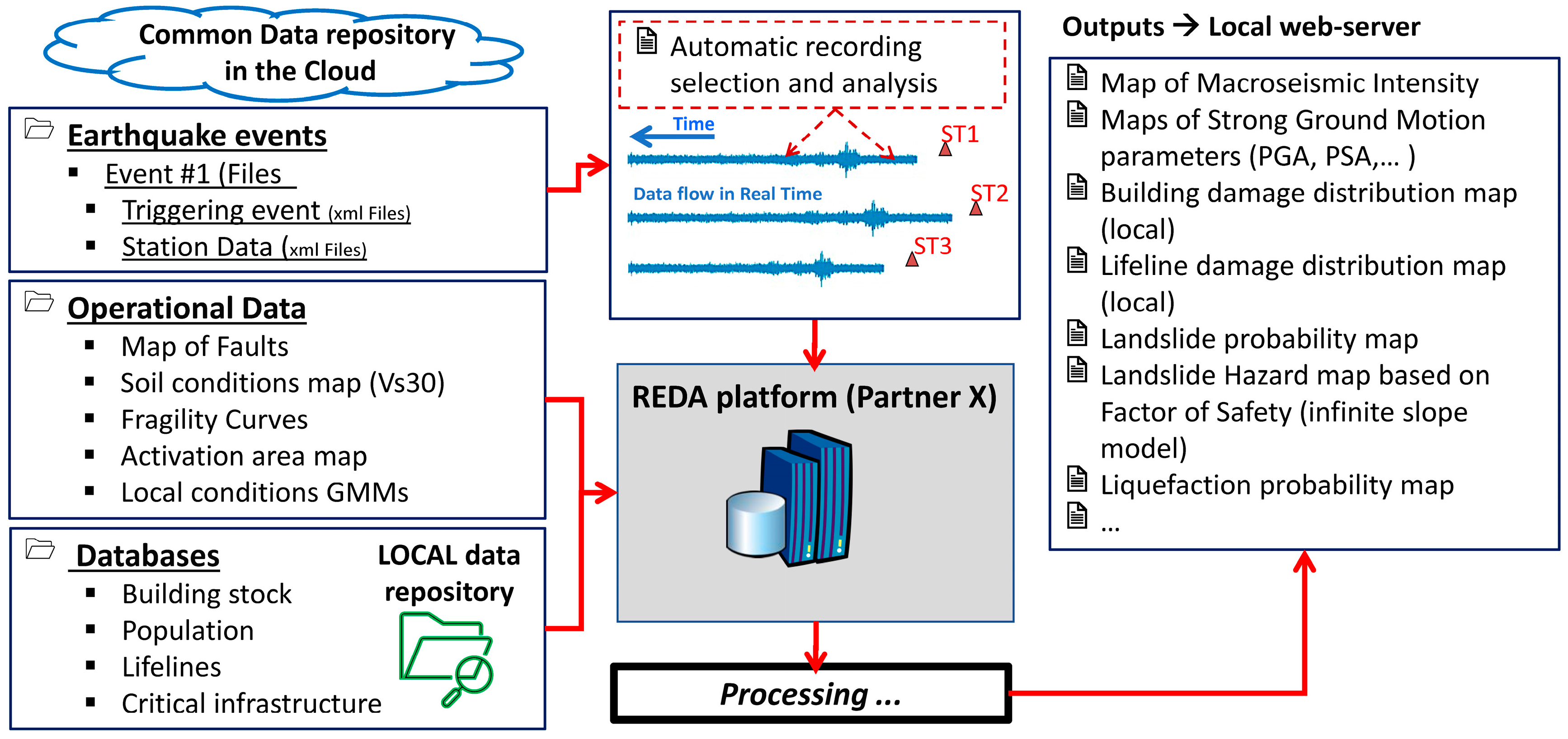
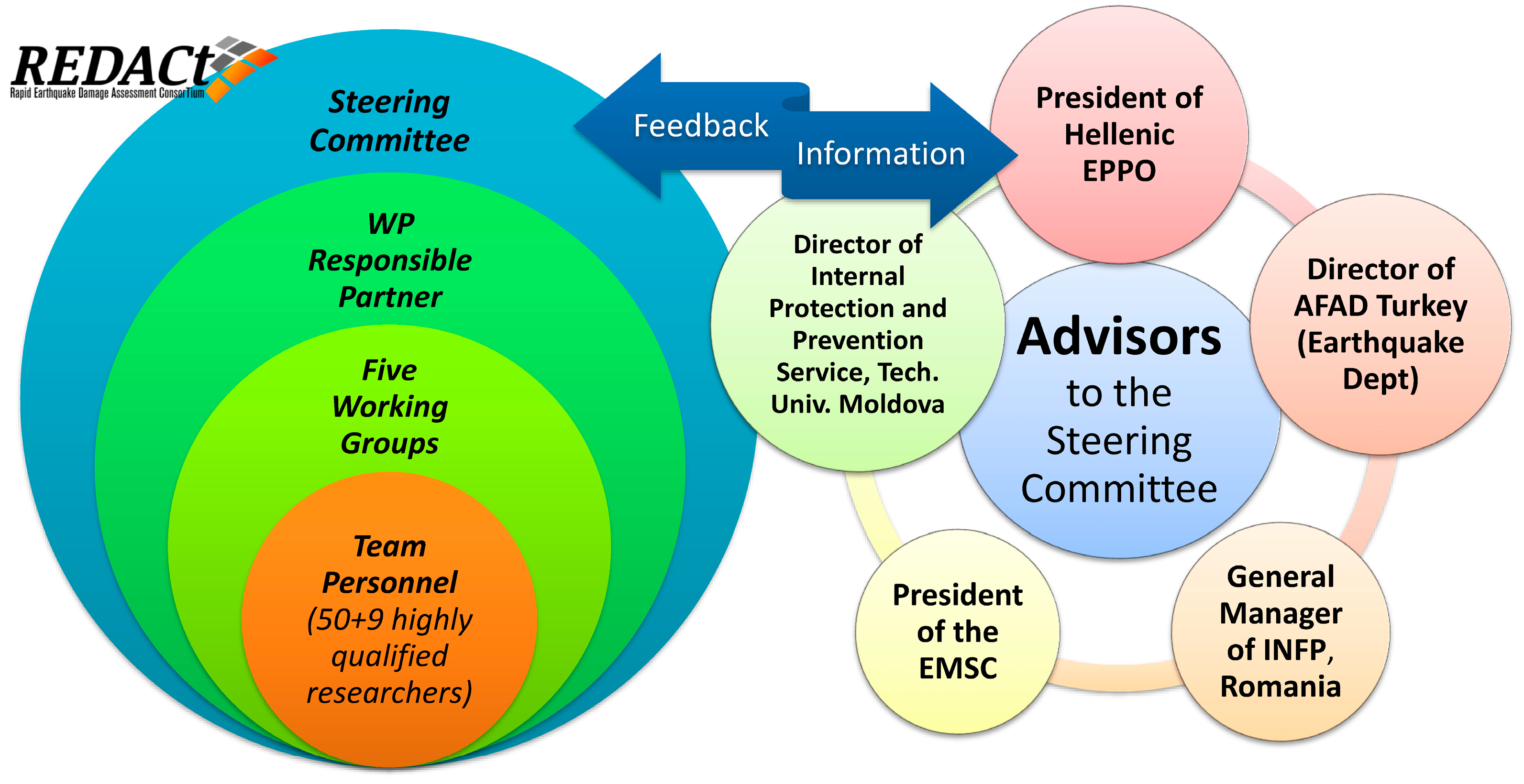
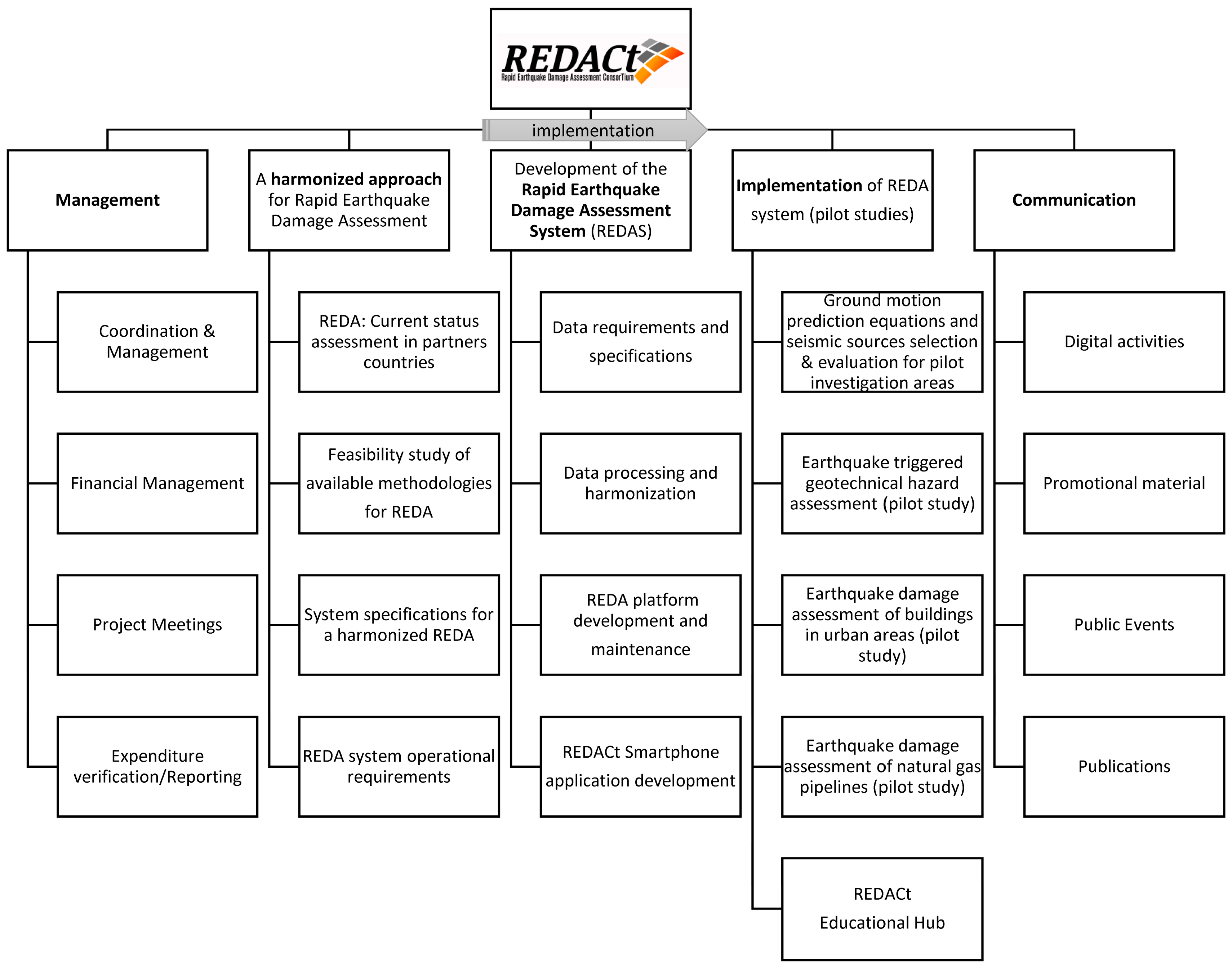
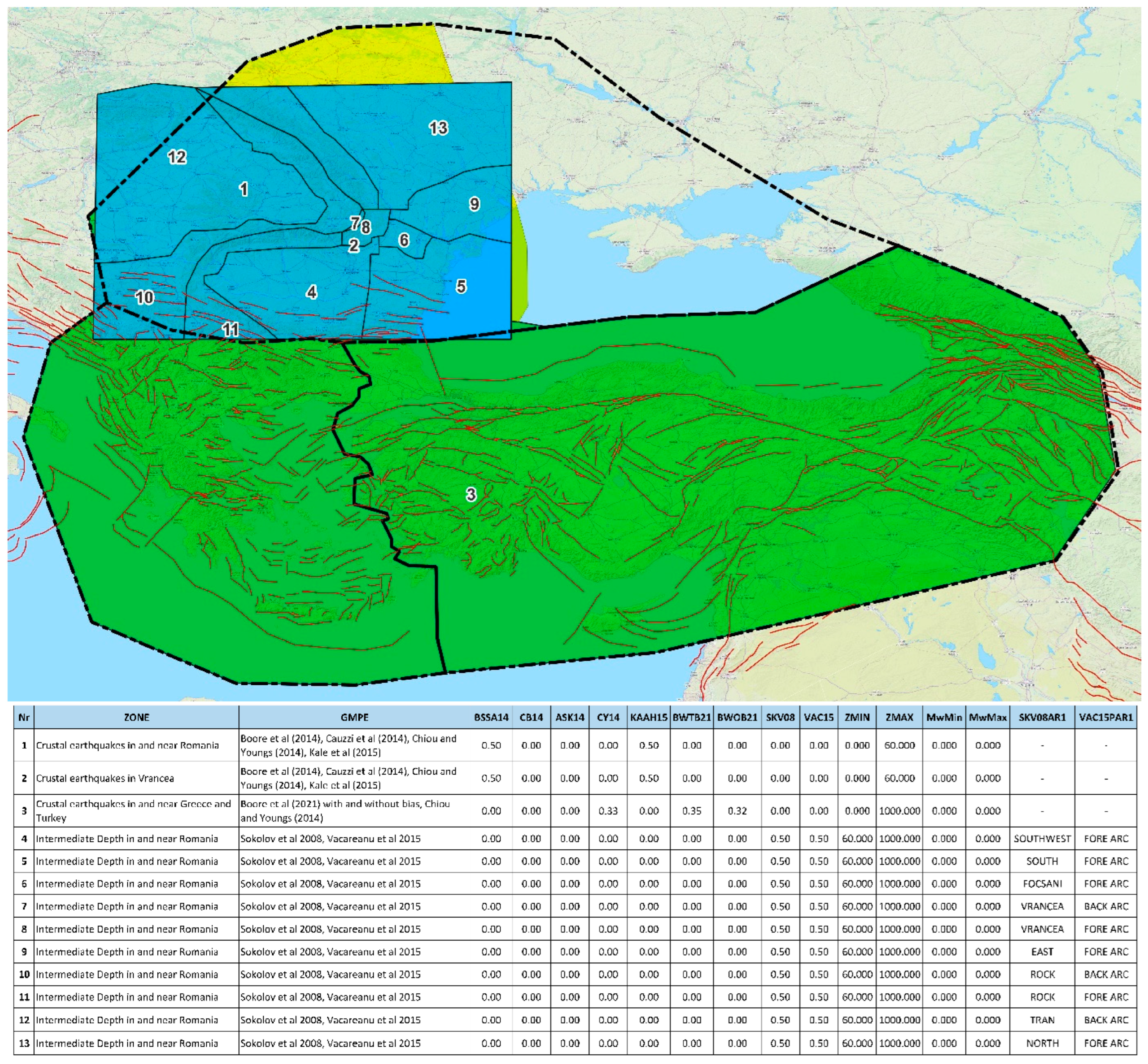

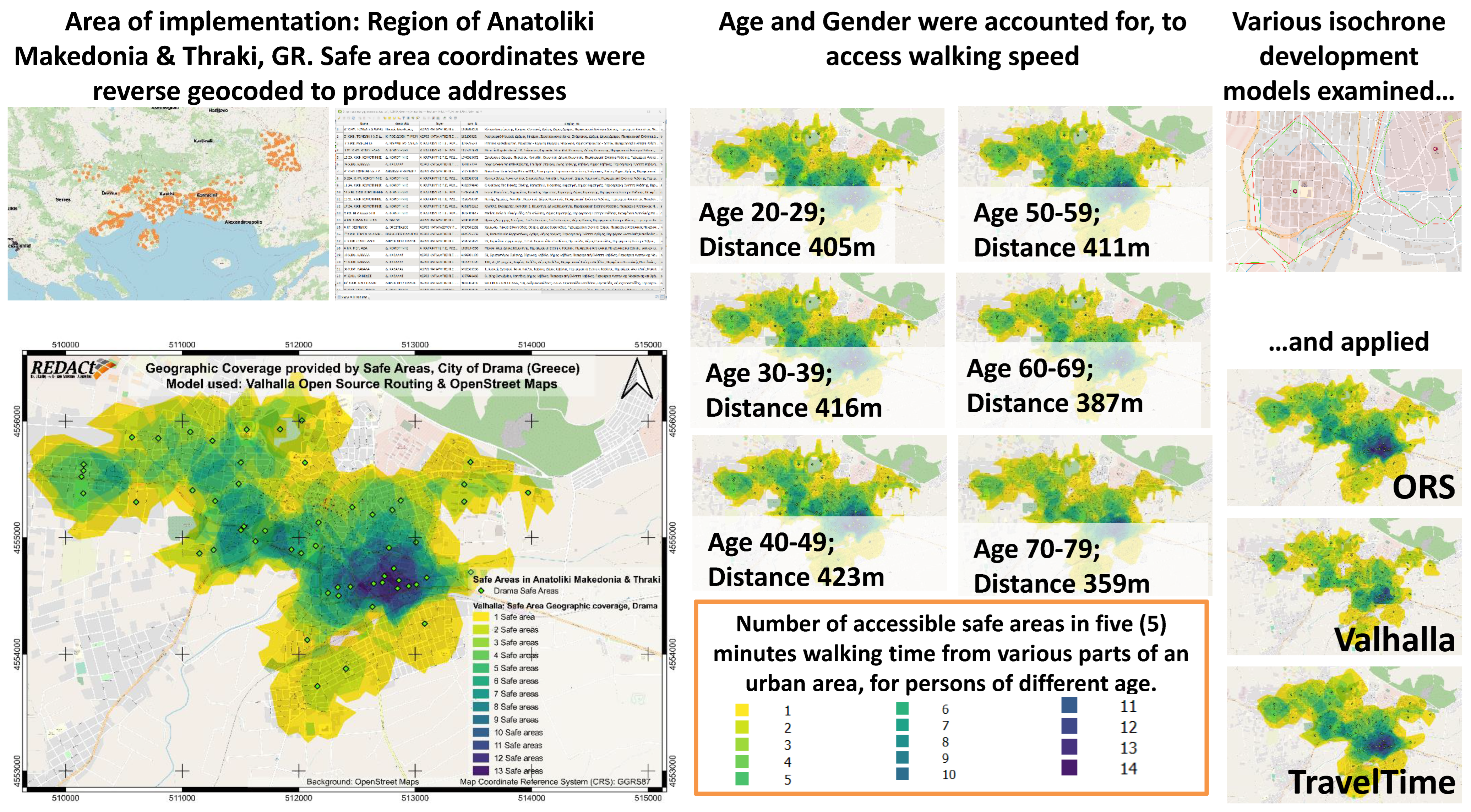
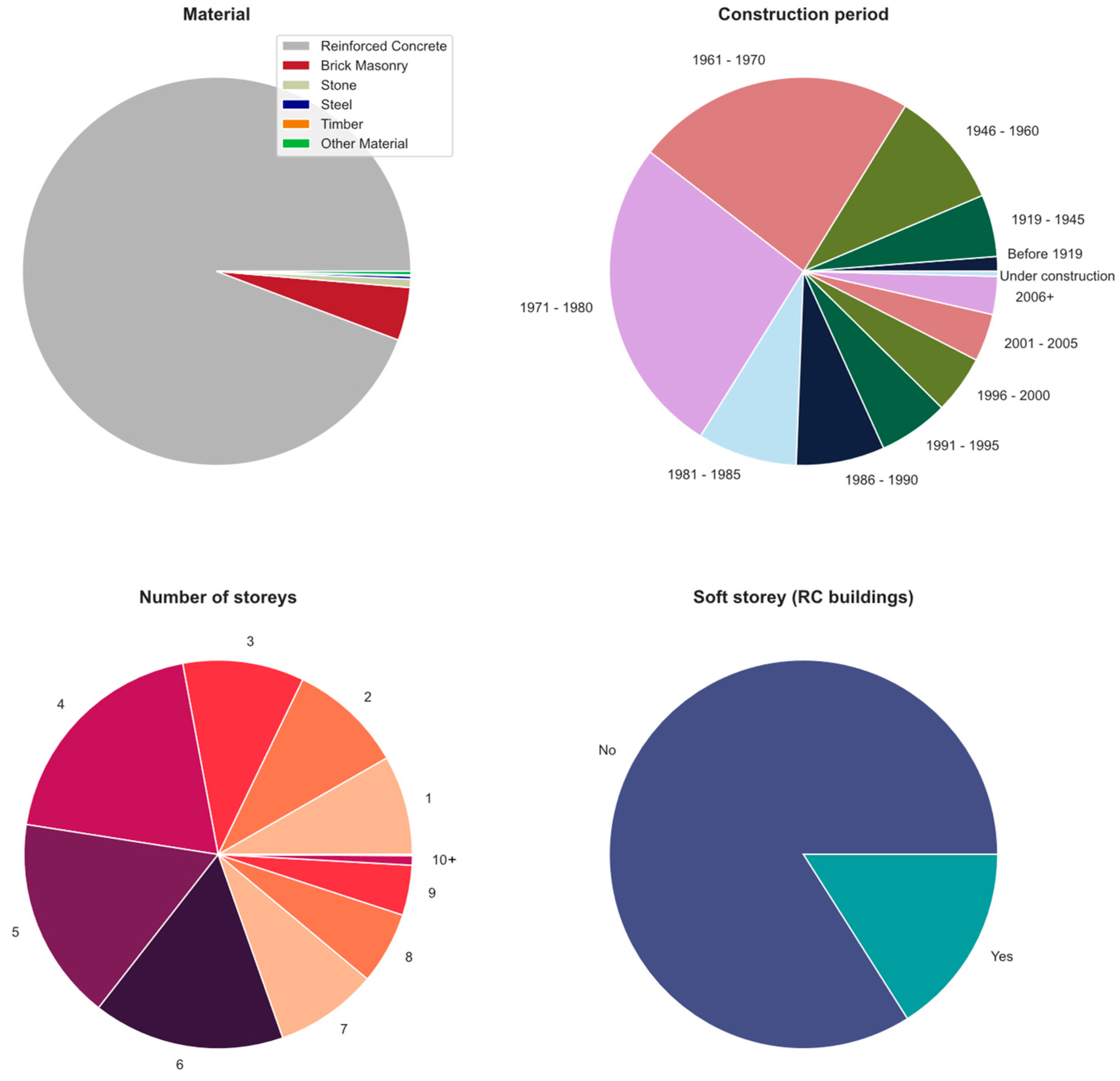

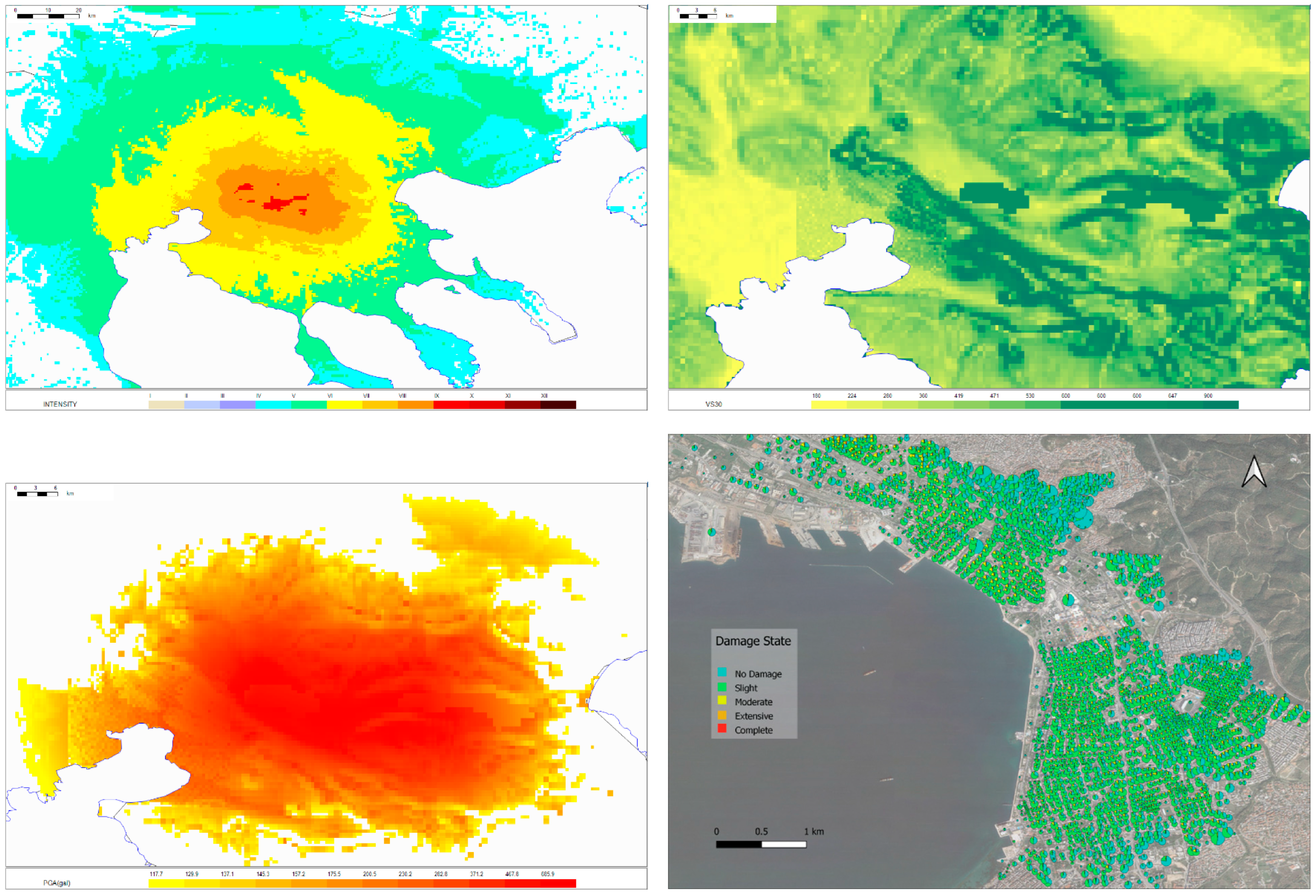
Disclaimer/Publisher’s Note: The statements, opinions and data contained in all publications are solely those of the individual author(s) and contributor(s) and not of MDPI and/or the editor(s). MDPI and/or the editor(s) disclaim responsibility for any injury to people or property resulting from any ideas, methods, instructions or products referred to in the content. |
© 2023 by the authors. Licensee MDPI, Basel, Switzerland. This article is an open access article distributed under the terms and conditions of the Creative Commons Attribution (CC BY) license (https://creativecommons.org/licenses/by/4.0/).
Share and Cite
Papatheodorou, K.; Theodoulidis, N.; Klimis, N.; Zulfikar, C.; Vintila, D.; Cardanet, V.; Kirtas, E.; Toma-Danila, D.; Margaris, B.; Fahjan, Y.; et al. Rapid Earthquake Damage Assessment and Education to Improve Earthquake Response Efficiency and Community Resilience. Sustainability 2023, 15, 16603. https://doi.org/10.3390/su152416603
Papatheodorou K, Theodoulidis N, Klimis N, Zulfikar C, Vintila D, Cardanet V, Kirtas E, Toma-Danila D, Margaris B, Fahjan Y, et al. Rapid Earthquake Damage Assessment and Education to Improve Earthquake Response Efficiency and Community Resilience. Sustainability. 2023; 15(24):16603. https://doi.org/10.3390/su152416603
Chicago/Turabian StylePapatheodorou, Konstantinos, Nikolaos Theodoulidis, Nikolaos Klimis, Can Zulfikar, Dragos Vintila, Vladlen Cardanet, Emmanouil Kirtas, Dragos Toma-Danila, Basil Margaris, Yasin Fahjan, and et al. 2023. "Rapid Earthquake Damage Assessment and Education to Improve Earthquake Response Efficiency and Community Resilience" Sustainability 15, no. 24: 16603. https://doi.org/10.3390/su152416603
APA StylePapatheodorou, K., Theodoulidis, N., Klimis, N., Zulfikar, C., Vintila, D., Cardanet, V., Kirtas, E., Toma-Danila, D., Margaris, B., Fahjan, Y., Panagopoulos, G., Karakostas, C., Papathanassiou, G., & Valkaniotis, S. (2023). Rapid Earthquake Damage Assessment and Education to Improve Earthquake Response Efficiency and Community Resilience. Sustainability, 15(24), 16603. https://doi.org/10.3390/su152416603






